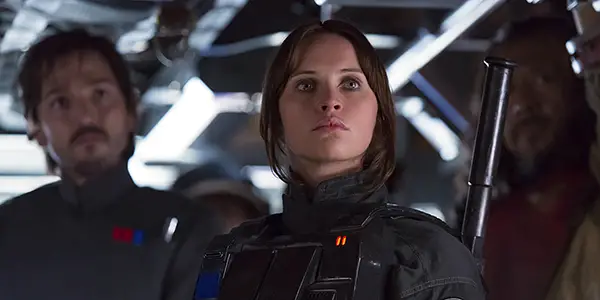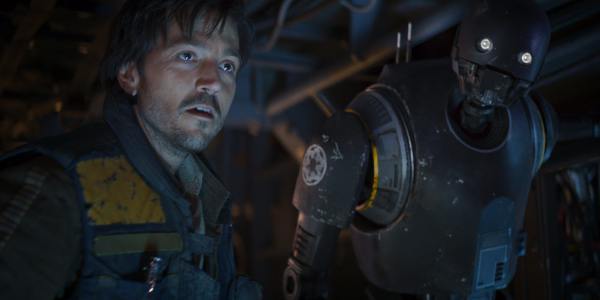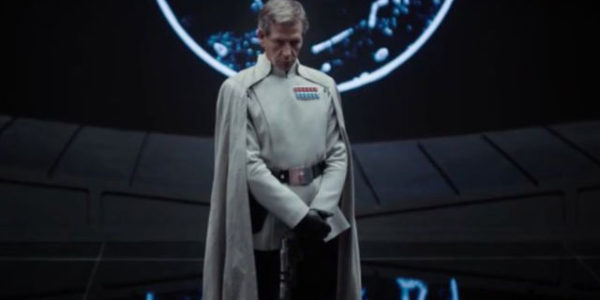ROGUE ONE: A STAR WARS STORY: Anything But Rogue

Stephanie Archer is 39 year old film fanatic living in…
When the word “prequel” comes into a conversation with regards to the Star Wars universe, many will find critics and audiences alike shuddering at the thought. Without fail, someone will inevitably state their case on why the prequels were an abomination – expectantly bringing up the long standing argument against the existence of Jar Jar Binks. So it was no surprise that the announcement of Rogue One: A Star Wars Story was met with hesitation and some resistance. While curiosity did linger, it wasn’t until the success of J.J. Abrams’ Star Wars: The Force Awakens, as well as the release of the first trailer for Rogue One, that the excitement for this film quickly began to build.
Fans flocked to theaters, hoping their devotion to the franchise would once again be rewarded. Where the prequels failed to satisfy hungry fans around the world, Rogue One: A Star Wars Story surpassed all expectations. With tributes to the original films, as well as the external universe, fans will find that this is the prequel they have been waiting for. Yet, the beauty of Rogue One is that you don’t have to be a fan to enjoy it. There is a solid story that needs no backstory, and no explanation.
Rogue One not only satisfies the hearts of fans alike, but is a further testament to the decision regarding the sale of Star Wars and the passing of the torch onto new storytellers. J.J. Abrams and Gareth Edwards (director of Rogue One) bring a new refreshing, yet respectful take on the franchise that they have clearly grown up with, and have emulated over the years. Combining this passion with a solid cast and state-of-the-art technology, the Star Wars franchise has once again found the magic that made it a success, and Rogue One now has a place in the hearts of fans everywhere.
Plot
Like the prequels, viewers will know how Rogue One: A Star Wars Story will end. In the prequels, Anakin Skywalker becomes Darth Vader and here, the Death Star plans are retrieved and delivered into the hands of the Rebellion. The exciting part of the ride is finding out how all this transpired.

While the film does begin with the same “traveling spaceship within space” opening shot as its predecessors, the film lacks its signature crawl – a decision that, while at first was unfavored, made cinematic sense to help enforce the identity of this standalone film and separate it from the Saga.
The film’s beginning was the only weakness identifiable within it. Following a flashback to the final moments our heroine saw her family, viewers are introduced to a vast amount of characters and locations in a very short period of time. Some viewers, especially those unfamiliar with the franchise, may find the rapid transitions overwhelming, finding themselves lost in space.
The film quickly recovers with the rescue of our heroine, Jyn Erso (played by Felicity Jones) by the Rebel Alliance. Jyn Erso, the daughter of Galen Erso (played by Mads Mikkelsen), parallels characters of previous films. She was separated from her family at a young age and has been in hiding ever since – yet instead of longing to embrace and join in the fight as the characters she parallels, she only wants freedom for herself. With her rescue comes the chance to make this possible.
The rebel Alliance has received word from an imperial pilot of a new weapon developed by the Empire that could threaten their existence, as well as the freedom of the Galaxy. A weapon, powerful enough to destroy entire planets, is nearing completion and there is little time to stop it. Galen Erso, the father of Jyn, is believed to be the lead developer on the project, and he alone may hold the key to the destruction of the ultimate weapon. Rumors swirl that a message from Galen was delivered to an old friend, Saw Gerrera (played by Forest Whitaker) – a man feared by all, yet the surrogate family to our young heroine.
In exchange for her freedom, Jyn Erso is enlisted by the Rebellion to seek an audience with Gerrera to obtain this message. She is believed to be the only hope the Alliance has to uncovering a weakness and save the Galaxy. With her acceptance of the mission, Jyn is thrown into the core of the fight against the empire, and with the support of those around her, may find something worth fighting for – hope. Crescendoing into an epic and satisfying conclusion, Rogue One delivers a solid and worthwhile movie experience, worthy of standing beside the films that came before it.
CGI And The Ethics Of Digital Resurrection
While the story itself was successful, and execution brilliantly done, Rogue One will be remembered for two main things – the return of Darth Vader to the big screen and the recreations of the original film’s most known characters. Fans rejoiced at seeing one of cinema’s greatest villains make his return to the big screen, yet it was the return of two other characters that had audiences talking weeks after the film had premiered.

Through the magic of CGI, General Tarkin (originally played by Peter Cushing, who passed away in 1994) and Princess Leia, (originally played by Carrie Fisher, who sadly passed away late 2016) were brought back to life on the big screen. Through careful study of the lighting and movement of the original characters, and with the use of motion-capture equipment on actors’ heads, these characters were able to be digitally reconstructed. Their presence in the film created deep nostalgia in audiences, and creatively paved the way for continuity between Rogue One and Star Wars: A New Hope.
Yet, with the display in state-of-the-art CGI technology that brought back to life the feared General Tarkin and beloved Princess Leia comes a vast array of critics and fans, questioning whether this is something we should do. Should digital reconstructions of actors long since passed be brought back to life, their images utilized long after they are gone to satisfy the wants of the industry and the hearts of fans?
When you think about it, this is only a further example of the need accolades have to keep their idols alive, and an industry’s willingness to do so. The CGI recreations of Princess Leia and General Tarkin only follow behind previous trends of resurrections such as holograms (Michael Jackson) and bands recasting long lost similarly voiced lead singers (Sublime, Alice in Chains). Looking at the larger picture does not negate the question, but does allow us to see the evolutionary reconstruction process we have been building up over the last few years that have led to this moment in film.
Heart Of A Generation
In 2012, George Lucas shocked fans around the world when he announced that he had sold his beloved franchise to Disney, saying “it’s now time for me to pass Star Wars on to a new generation of filmmakers” (as was reported by Business Insider 2012). Many fans were unsure how this transfer of power would play out for future Star Wars films and for the franchise altogether. Many, including myself, felt that the “magic” of Disney would leak through and ruin the brilliant saga we had loved so much.

Then Star Wars: The Force Awakens premiered. The heart and love for the franchise poured through the script and the film that was brought to life for audiences around the world. Fans and critics rejoiced at the care, respect, and excellence that went into the making of the film. But could lightning strike twice? Rumors swirled, as retakes for Rogue One began to film, that Disney was unhappy with their first viewing of the movie. Fans and critics began expressing their doubt that Rogue One could be as true to the franchise as The Force Awakens had been.
Once again, however, the heart of a generation delivered. Gareth Edwards delivers a film that was a clear display of his love for the franchise, as well as the want and need to make Rogue One a success. When watching this film, as with The Force Awaken, viewers feel as though this film was made for them – not made for their money. There is a feeling of trust and understanding that is created and upheld between the filmmaker and the audience – a bond that only strengthens the belief and expectations for the future.
Conclusion
Rogue One: A Star Wars Story is one of hope – not only for the characters on screen but also for the audience. Following in the footsteps of J. J. Abrams‘ film Star Wars: The Force Awakens, Disney brilliantly executed another film in the Star Wars franchise, easing the doubts of fans and furthering our expectations on what we can expect from the franchise in the films to follow.
A solid story, cast, and advancement in technology lifted this film and carried it to become the blockbuster it deserved to be. With the nostalgia and success of Rogue One, many will find themselves yearning to strike up Star Wars: A New Hope the moment they are home.
Have you seen Rogue One: A Star Wars Story? Tell us what you thought in the comments below!
Rogue One: A Star Wars Story was released World Wide on December 16, 2016. For a list of released dates, see here.
Does content like this matter to you?
Become a Member and support film journalism. Unlock access to all of Film Inquiry`s great articles. Join a community of like-minded readers who are passionate about cinema - get access to our private members Network, give back to independent filmmakers, and more.













